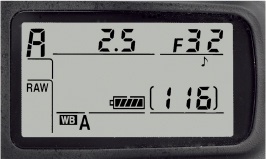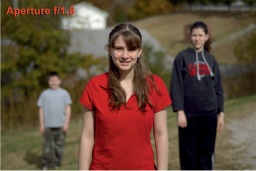Depth of field is one of those things that confuses a lot of new DSLR users. Yet, it is very important! I’m going to attempt to explain this concept using pictures. This topic transcends the actual DSLR being used—in fact, my illustrations were created with my trusty Nikon D2X.
Let’s say you are taking a picture of a friend, who is standing 6 feet (2 m) away from you. About 6 feet behind your friend is another person. There is also a third person standing about 6 feet behind the second person. Three people total, each about 6 feet apart, with the friend in front (see Figure 2-11).
You are shooting with a 50 mm f/1.8 lens. You focus on your friend’s face, the young lady in red, and take a picture. It looks like the image in Figure 2-11.
F/1.8 is an aperture number. An aperture is simply an opening in the front of your lens controlled by blades. It lets light come in through the lens to expose your D700’s sensor. You can’t see the aperture when you look in the front of your lens (usually) since your D700 allows you to focus with the aperture blades wide open and out of the way. The aperture closes down to its selected setting when you press the shutter release to take your picture, or press the depth of field Preview button. This is the reason the viewfinder often gets darker when you press the DOF Preview button on your camera.
Apertures on your zoom lens probably start at about f/3.5 (big aperture) and stop at f/22 (small aperture). The bigger the aperture can get (the larger the opening), the “faster” the lens is considered. When you hear about a “fast” lens, someone is talking about a lens with a big maximum aperture opening. The 50 mm f/1.8 lens is a fast lens.
Notice in Figure 2-11 that your friend (in red) is in sharp focus. The girl standing behind her, to the right, is not in focus, nor is the young lad even farther away to the left. This is the result of shooting with a big aperture. F/1.8 is a big opening in the front of your lens. It also causes the depth of field, or “zone of sharp focus”, to be shallow. Only the girl in front is in focus at f/1.8. Not much else is in focus, so there is very little depth of field. The depth of field in this picture is much less than 3 feet (.91 m) deep; probably more like 1.5 feet (.45 m).
So what would happen if we closed the aperture down (“stopped” down) to a medium aperture like f/8? Figure 2-12 shows what that will do to the depth of field.
Remember, you are focused on the girl in front, and at f/1.8, a big fast aperture, the others were out of focus. Without changing your focus in any way, you adjusted your aperture to f/8. Something changed!
You focused your camera on the girl in front, but now the girl to the right is sharp too, even though you did not change your focus control. The depth of field (or zone of sharp focus) now extends past the girl in front and covers the girl in back. The DOF got deeper.
However, also notice that the boy to the left is still not in focus. The background is not in focus either. The depth of field is deeper but still not deep enough to cover all your subjects.
This image is the result of a medium aperture opening (f/8), not fast (f/1.8) and not slow (f/22). Now, let’s consider what happens if we “stop down”, or close the aperture, to a small opening like f/22 (Figure 2-13).
Aha! Now everything in the picture is sharp. An aperture as slow and small as f/22 makes it easy to get sharp focus. Remember, you focused on the girl in front in all these pictures. At first only the girl in red was in focus (f/1.8), and as the aperture got smaller, more and more of the surroundings came into sharp focus (f/8 and f/22).
So, depth of field is simply the zone of sharp focus. It extends in front of and behind your focused subject and gets deeper in both directions, toward the camera and away from it, as you “stop down” your lens. If you set your camera to Aperture Priority Auto (or Manual mode), you can adjust this powerful functionality to control what is in focus in your pictures. Don’t forget that in this case you are also making trade-offs. All three images were shot at ISO 100, and once you started using the smaller apertures, the camera needed to compensate by using longer exposure times. The f1.8 shot was at ![]() second. The f/8 shot was at
second. The f/8 shot was at ![]() second. The f/22 final image required an exposure of merely
second. The f/22 final image required an exposure of merely ![]() second. This was fairly easy to pull off under sunny skies with stationary subjects, but you can see where the shutter speed exposure compensations could get troublesome if these three subjects were playing ball or jumping around. This is when the experienced photographer takes advantage of the Manual mode.
second. This was fairly easy to pull off under sunny skies with stationary subjects, but you can see where the shutter speed exposure compensations could get troublesome if these three subjects were playing ball or jumping around. This is when the experienced photographer takes advantage of the Manual mode.




